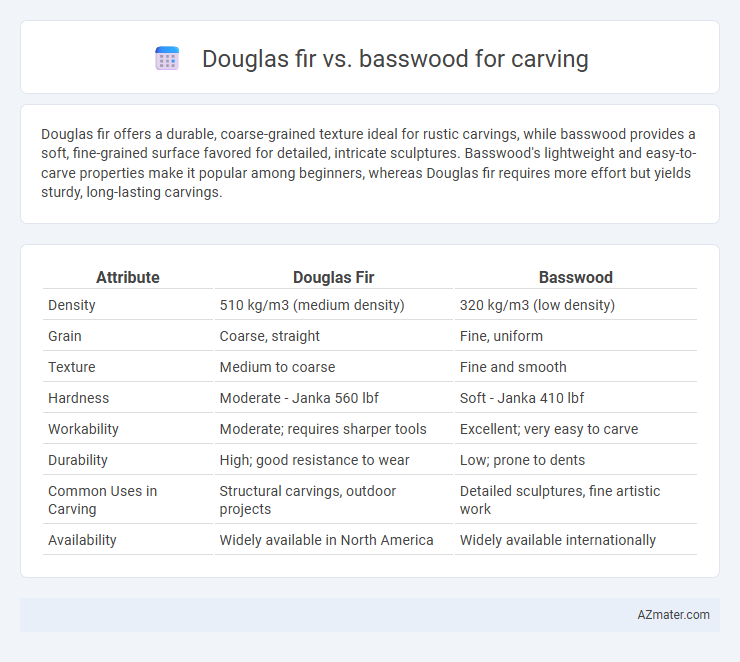Douglas fir offers a durable, coarse-grained texture ideal for rustic carvings, while basswood provides a soft, fine-grained surface favored for detailed, intricate sculptures. Basswood's lightweight and easy-to-carve properties make it popular among beginners, whereas Douglas fir requires more effort but yields sturdy, long-lasting carvings.
Table of Comparison
| Attribute | Douglas Fir | Basswood |
|---|---|---|
| Density | 510 kg/m3 (medium density) | 320 kg/m3 (low density) |
| Grain | Coarse, straight | Fine, uniform |
| Texture | Medium to coarse | Fine and smooth |
| Hardness | Moderate - Janka 560 lbf | Soft - Janka 410 lbf |
| Workability | Moderate; requires sharper tools | Excellent; very easy to carve |
| Durability | High; good resistance to wear | Low; prone to dents |
| Common Uses in Carving | Structural carvings, outdoor projects | Detailed sculptures, fine artistic work |
| Availability | Widely available in North America | Widely available internationally |
Introduction to Douglas Fir and Basswood
Douglas fir, known scientifically as Pseudotsuga menziesii, is a dense and moderately soft conifer commonly used in carving for its fine grain and durability, making it ideal for outdoor sculptures. Basswood, or Tilia americana, is a soft hardwood preferred by carvers due to its lightweight texture, uniform grain, and ease of detail work, especially in intricate or delicate designs. The choice between Douglas fir and basswood depends on factors such as desired texture, carving complexity, and project longevity.
Wood Properties: Density and Grain
Douglas fir has a density of approximately 530 kg/m3, making it moderately hard and suitable for sturdy carvings, while its coarse grain can add texture but may require more effort to achieve fine details. Basswood, with a lower density around 320 kg/m3, is softer and easier to carve, featuring a fine, even grain that allows for smooth finishes and intricate designs. These wood properties make basswood a preferred choice for delicate and detailed carving projects, whereas Douglas fir is better suited for larger, more robust works.
Carving Ease: Workability Comparison
Douglas fir offers moderate carving ease due to its relatively straight grain and medium hardness, making it suitable for larger, less detailed projects but challenging for intricate work. Basswood is highly favored for carving because of its soft texture, fine even grain, and minimal resistance, allowing carvers to achieve precise details with minimal effort. Basswood's superior workability makes it the preferred choice for beginners and detailed sculpting compared to Douglas fir's sturdier yet less forgiving characteristics.
Durability and Strength for Finished Pieces
Douglas fir offers exceptional durability and strength, making it ideal for carving projects that require sturdy, long-lasting finished pieces. Basswood is significantly softer and less dense, which allows for easier carving but results in finished items that are more prone to dents and wear over time. For projects demanding robust structural integrity and resistance to damage, Douglas fir is the preferred choice due to its superior hardness and resilience.
Detailing and Fine Carving Potential
Douglas fir features a coarser grain with resin pockets, making it less ideal for intricate detailing compared to basswood. Basswood is renowned for its fine, even texture and soft density, allowing for precise cuts and smooth finishes in delicate carving work. Its ability to hold sharp details without splintering makes basswood the preferred choice for fine carvings and detailed sculptural projects.
Tool Wear and Maintenance
Douglas fir, with its coarse grain and moderate hardness, tends to cause less tool wear compared to harder woods but may require more frequent resharpening due to occasional resin buildup. Basswood's soft, fine-grained texture significantly reduces blade dulling, making it ideal for intricate carving with minimal maintenance of tools. Maintaining sharp edges is critical for both woods, but basswood generally demands less frequent sharpening and cleaning, thereby enhancing tool longevity and reducing upkeep time.
Finishing and Paint Absorption
Douglas fir has a coarse grain and resinous knots, leading to uneven paint absorption and a rough finish that may require extensive sanding and priming for a smooth surface. Basswood features a fine, even grain with a soft texture that absorbs paint uniformly, resulting in a smooth, high-quality finish ideal for detailed carving projects. The low resin content and consistent density of basswood make it preferable for achieving vibrant paint colors and a flawless finish without excessive preparation.
Availability and Cost
Douglas fir is widely available across North America, making it a common and cost-effective choice for woodcarving projects, especially for beginners. Basswood, although generally more expensive, is favored for its fine grain and softness, which allows for detailed carving and smooth finishes. Both woods vary in price based on region and supply, but Douglas fir typically offers better affordability and accessibility compared to basswood.
Common Carving Applications
Douglas fir is favored for outdoor carving projects such as totem poles and garden sculptures due to its durability and resistance to decay, making it ideal for weather-exposed applications. Basswood is a preferred choice for detailed indoor carving like figurines, relief carvings, and intricate artwork because of its fine, even grain and softness, allowing for precise cuts and smooth finishes. Both woods offer distinct advantages: Douglas fir excels in structural and large-scale carvings, while basswood suits delicate and detailed craftsmanship.
Choosing the Right Wood for Your Project
Douglas fir offers a dense grain with moderate hardness, making it suitable for larger, robust carving projects that require durability and strength. Basswood is favored for its fine, even texture and softness, allowing for intricate detailing and ease of carving, ideal for delicate or beginner projects. Selecting between Douglas fir and basswood depends on the desired level of detail and the project's structural requirements, with basswood excelling in precision and Douglas fir in toughness.

Infographic: Douglas fir vs Basswood for Carving
 azmater.com
azmater.com